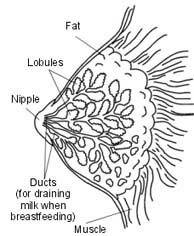What is it?
The part of the breast tissue that has formed a lump, or a cyst, or is not normal, is removed.
The Operation
You will have a general anaesthetic and will be completely asleep during the operation. A cut is made in the skin over or near the affected part of the breast. A place will be chosen that will heal nicely. Only the affected part of the breast is removed. The cut in the skin is closed up. There may be a fine plastic drain tube running from the wound. Your operation can usually be done as a day case. This means that you come into hospital on the day of the operation and go home the same day.

Any Alternatives
If you leave the breast as it is, the problem remains. We will not be clear what is going on. You may miss out on important treatment. X-rays and scans will not tell us any more about the problem area in the breast. Treatment by antibiotics or hormones is not a good idea if the cause of the problem is not known.
Before the operation
Stop smoking and get your weight down. (See Healthy Living). If you know that you have problems with your blood pressure, your heart, or your lungs, ask your family doctor to check that these are under control. Check the hospital's advice about taking the pill or hormone replacement therapy (HRT). Check you have a relative or friend who can come with you to hospital and take you home. Bring all your tablets and medicines with you to hospital. On the ward, you may be checked for past illnesses and may have special tests, ready for the operation. Many hospitals now run special preadmission clinics, where you visit for an hour or two, a few weeks or so before the operation for these checks.
After - In Hospital
There may be some discomfort in the breast. Pain killing tablets should easily control this. If not, you can have painkilling injections. By the end of one week the wound should be just about pain-free. A general anaesthetic will make you slow, clumsy and forgetful for about 24 hours. Do not make important decisions, drive a car, use machinery, or even boil a kettle during that time. The wound may be closed with stitches, clips, or paper strips, which need to be taken out by the nurses about a week after the operation. Sometimes there are stitches under the skin instead.
These melt away, so that the wound does not need any more attention. Any drainage tube is usually removed when the wound is redressed, before you go home. You can wash, bathe, or shower as soon as the stitches, clips or paper strips are taken off. Soap and tap water are quite all right. Salted water is not needed. Most hospitals arrange a check up about one week or so after you leave hospital. The result of the examination of the breast tissue will be ready then. The nurses will advise about sick notes, certificates etc.
After - At Home
Have plenty of rest. Take mild painkillers as needed to control discomfort. You can drive as soon as you can make an emergency stop without discomfort in the wound, i.e. after about 2 days. You should be able to return to a light job after about 3 or 4 days , and any heavy job within 2 weeks.
Possible Complications
Complications are rare and seldom serious. In the first 24 hours: Look out for any bleeding coming through the dressings. After the first 24 hours: Bruising and swelling may be troublesome, particularly if the wound was large. The wound swelling may take 4 to 6 weeks to settle down. Infection is a rare problem and settles down with antibiotics in a week or two.
General Advice
These notes should help you through your operation. They are a general guide. They do not cover everything. Also, all hospitals and surgeons vary a little. If you have any queries or problems, please ask the doctors or nurses.
Advanced Reproductive Technology
- In Vitro Fertilisation (IVF)
- Intracytoplasmic Sperm Injection (ICSI)
- Donor egg and embryo programs
- In Vitro Fertilisation (IVF)
- Pre-implantation genetic diagnosis (PGD)
- Surrogacy programs
Dental Videos





